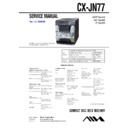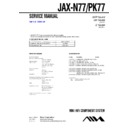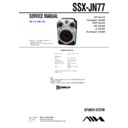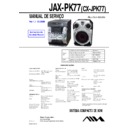Sony CX-JN77 / JAX-N77 / JAX-PK77 Service Manual ▷ View online
CX-JN77
2
Notes on chip component replacement
• Never reuse a disconnected chip component.
• Notice that the minus side of a tantalum capacitor may be dam-
aged by heat.
Flexible Circuit Board Repairing
• Keep the temperature of the soldering iron around 270 °C dur-
ing repairing.
• Do not touch the soldering iron on the same conductor of the
circuit board (within 3 times).
• Be careful not to apply force on the conductor when soldering
or unsoldering.
CAUTION
Use of controls or adjustments or performance of procedures
other than those specified herein may result in hazardous ra-
diation exposure.
other than those specified herein may result in hazardous ra-
diation exposure.
SAFETY-RELATED COMPONENT WARNING!!
COMPONENTS IDENTIFIED BY MARK
0
OR DOTTED
LINE WITH MARK
0
ON THE SCHEMATIC DIAGRAMS
AND IN THE PARTS LIST ARE CRITICAL TO SAFE
OPERATION. REPLACE THESE COMPONENTS WITH
SONY PARTS WHOSE PART NUMBERS APPEAR AS
SHOWN IN THIS MANUAL OR IN SUPPLEMENTS PUB-
LISHED BY SONY.
OPERATION. REPLACE THESE COMPONENTS WITH
SONY PARTS WHOSE PART NUMBERS APPEAR AS
SHOWN IN THIS MANUAL OR IN SUPPLEMENTS PUB-
LISHED BY SONY.
This appliance is classified as
a CLASS 1 LASER product.
The CLASS 1 LASER
PRODUCT MARKING is
located on the rear exterior.
a CLASS 1 LASER product.
The CLASS 1 LASER
PRODUCT MARKING is
located on the rear exterior.
UNLEADED SOLDER
Boards requiring use of unleaded solder are printed with the lead-
free mark (LF) indicating the solder contains no lead.
(Caution: Some printed circuit boards may not come printed with
free mark (LF) indicating the solder contains no lead.
(Caution: Some printed circuit boards may not come printed with
the lead free mark due to their particular size)
: LEAD FREE MARK
Unleaded solder has the following characteristics.
• Unleaded solder melts at a temperature about 40 °C higher than
• Unleaded solder melts at a temperature about 40 °C higher than
ordinary solder.
Ordinary soldering irons can be used but the iron tip has to be
applied to the solder joint for a slightly longer time.
Soldering irons using a temperature regulator should be set to
about 350
Ordinary soldering irons can be used but the iron tip has to be
applied to the solder joint for a slightly longer time.
Soldering irons using a temperature regulator should be set to
about 350
°C.
Caution: The printed pattern (copper foil) may peel away if the
heated tip is applied for too long, so be careful!
• Strong viscosity
Unleaded solder is more viscou-s (sticky, less prone to flow)
than ordinary solder so use caution not to let solder bridges oc-
cur such as on IC pins, etc.
than ordinary solder so use caution not to let solder bridges oc-
cur such as on IC pins, etc.
• Usable with ordinary solder
It is best to use only unleaded solder but unleaded solder may
also be added to ordinary solder.
also be added to ordinary solder.
General
Power requirements
European and Russian models:
European and Russian models:
230 V AC, 50/60 Hz
Mexican models:
127 V AC, 60 Hz
Other models:
120 V, 220 V or
230 – 240 V AC, 50/60 Hz
Adjustable with voltage
selector
230 – 240 V AC, 50/60 Hz
Adjustable with voltage
selector
Power consumption
European and Russian models:
European and Russian models:
180 watts
0.25 watts (at the Power
Saving Mode)
0.25 watts (at the Power
Saving Mode)
Other models:
170 watts
Dimensions (w/h/d) incl. projecting parts and controls
Amplifier/Tuner/Tape/CD section:
Amplifier/Tuner/Tape/CD section:
Approx. 280
× 325 ×
425 mm
Mass Approx.
9.9
kg
Design and specifications are subject to change
without notice.
without notice.
CX-JN77
3
TABLE OF CONTENTS
1.
SERVICING NOTES
................................................
4
2.
GENERAL
Location of Controls .......................................................
7
3.
DISASSEMBLY
3-1. Disassembly Flow ...........................................................
9
3-2. Case (Side-L/R) ............................................................... 10
3-3. Case (Top) ....................................................................... 10
3-4. Tray Panel ........................................................................ 11
3-5. CD Mechanism Deck (CDM74-F1BD81) ...................... 11
3-6. Front Panel Block ............................................................ 12
3-7. Back Panel Section .......................................................... 12
3-8. MAIN Board ................................................................... 13
3-9. Tape Mechanism Deck (CWM43FR34) ......................... 13
3-10. Table Assy ....................................................................... 14
3-11. MOTOR (TB) Board ....................................................... 14
3-12. MOTOR (LD) Board ....................................................... 15
3-13. Base Unit (BU-F1BD81A) ............................................. 15
3-14. CD Board ......................................................................... 16
3-3. Case (Top) ....................................................................... 10
3-4. Tray Panel ........................................................................ 11
3-5. CD Mechanism Deck (CDM74-F1BD81) ...................... 11
3-6. Front Panel Block ............................................................ 12
3-7. Back Panel Section .......................................................... 12
3-8. MAIN Board ................................................................... 13
3-9. Tape Mechanism Deck (CWM43FR34) ......................... 13
3-10. Table Assy ....................................................................... 14
3-11. MOTOR (TB) Board ....................................................... 14
3-12. MOTOR (LD) Board ....................................................... 15
3-13. Base Unit (BU-F1BD81A) ............................................. 15
3-14. CD Board ......................................................................... 16
4.
TEST MODE
.............................................................. 17
5.
ELECTRICAL ADJUSTMENTS
CD Section ...................................................................... 21
6.
DIAGRAMS
6-1. Block Diagram – SERVO Section – .............................. 22
6-2. Block Diagram – MAIN Section – ................................ 23
6-3. Block Diagram
6-2. Block Diagram – MAIN Section – ................................ 23
6-3. Block Diagram
– PANEL/POWER SUPPLY Section – .......................... 24
6-4. Note for Printed Wiring Boards and
Schematic Diagrams ....................................................... 25
6-5. Printed Wiring Board – CD Board – ............................. 26
6-6. Schematic Diagram – CD Board – ................................ 27
6-7. Printed Wiring Boards – CHANGER Section – ............ 28
6-8. Schematic Diagram – CHANGER Section – ................ 29
6-9. Printed Wiring Boards
6-6. Schematic Diagram – CD Board – ................................ 27
6-7. Printed Wiring Boards – CHANGER Section – ............ 28
6-8. Schematic Diagram – CHANGER Section – ................ 29
6-9. Printed Wiring Boards
– CDMP3 CONNECT/TRANSLATION Boards – ........ 30
6-10. Schematic Diagram
– CDMP3 CONNECT/TRANSLATION Boards – ........ 31
6-11. Schematic Diagram – MAIN Section (1/4) – ................ 32
6-12. Schematic Diagram – MAIN Section (2/4) – ................ 33
6-13. Schematic Diagram – MAIN Section (3/4) – ................ 34
6-14. Schematic Diagram – MAIN Section (4/4) – ................ 35
6-15. Printed Wiring Boards – MAIN Section – .................... 36
6-16. Printed Wiring Board – PANEL Section – .................... 37
6-17. Schematic Diagram – PANEL Section (1/2) – .............. 38
6-18. Schematic Diagram – PANEL Section (2/2) – .............. 39
6-19. Printed Wiring Board – POWER AMP Section –
6-12. Schematic Diagram – MAIN Section (2/4) – ................ 33
6-13. Schematic Diagram – MAIN Section (3/4) – ................ 34
6-14. Schematic Diagram – MAIN Section (4/4) – ................ 35
6-15. Printed Wiring Boards – MAIN Section – .................... 36
6-16. Printed Wiring Board – PANEL Section – .................... 37
6-17. Schematic Diagram – PANEL Section (1/2) – .............. 38
6-18. Schematic Diagram – PANEL Section (2/2) – .............. 39
6-19. Printed Wiring Board – POWER AMP Section –
(AEP, UK, CIS only) ....................................................... 40
6-20. Schematic Diagram – POWER AMP Section –
(AEP, UK, CIS only) ....................................................... 41
6-21. Printed Wiring Board – POWER AMP Section –
(E51, MX only) ............................................................... 42
6-22. Schematic Diagram – POWER AMP Section –
(E51, MX only) ............................................................... 43
6-23. Printed Wiring Boards – TRANS Section –
(AEP, UK, CIS only) ....................................................... 44
6-24. Schematic Diagram – TRANS Section –
(AEP, UK, CIS only) ....................................................... 45
6-25. Printed Wiring Boards – TRANS Section –
(E51, MX only) ............................................................... 46
6-26. Schematic Diagram – TRANS Section –
(E51, MX only) ............................................................... 47
7.
EXPLODED VIEWS
7-1. Case Section .................................................................... 58
7-2. Tape Mechanism Deck Section (CWM43FR34) ............ 59
7-3. Cassette Box Section ...................................................... 60
7-4. Front Panel Section ......................................................... 61
7-5. Back Panel Section .......................................................... 62
7-6. Chassis Section ............................................................... 63
7-7. CD Mechanism Deck Section-1 (CDM74-F1BD81) ..... 64
7-8. CD Mechanism Deck Section-2 (CDM74-F1BD81) ..... 65
7-9. CD Mechanism Deck Section-3 (CDM74-F1BD81) ..... 66
7-10. Base Unit Section (BU-F1BD81A) ................................ 67
7-2. Tape Mechanism Deck Section (CWM43FR34) ............ 59
7-3. Cassette Box Section ...................................................... 60
7-4. Front Panel Section ......................................................... 61
7-5. Back Panel Section .......................................................... 62
7-6. Chassis Section ............................................................... 63
7-7. CD Mechanism Deck Section-1 (CDM74-F1BD81) ..... 64
7-8. CD Mechanism Deck Section-2 (CDM74-F1BD81) ..... 65
7-9. CD Mechanism Deck Section-3 (CDM74-F1BD81) ..... 66
7-10. Base Unit Section (BU-F1BD81A) ................................ 67
8.
ELECTRICAL PARTS LIST
............................... 68
• Abbreviation
E51
: Chilean and Peruvian models
MX
: Mexican model
4
CX-JN77
+
–
+
R
L
R
L
–
– Rear View –
PART No.
SECTION 1
SERVICING NOTES
NOTES ON HANDLING THE OPTICAL PICK-UP
BLOCK OR BASE UNIT
BLOCK OR BASE UNIT
The laser diode in the optical pick-up block may suffer electro-
static break-down because of the potential difference generated
by the charged electrostatic load, etc. on clothing and the human
body.
During repair, pay attention to electrostatic break-down and also
use the procedure in the printed matter which is included in the
repair parts.
The flexible board is easily damaged and should be handled with
care.
static break-down because of the potential difference generated
by the charged electrostatic load, etc. on clothing and the human
body.
During repair, pay attention to electrostatic break-down and also
use the procedure in the printed matter which is included in the
repair parts.
The flexible board is easily damaged and should be handled with
care.
NOTES ON LASER DIODE EMISSION CHECK
The laser beam on this model is concentrated so as to be focused
on the disc reflective surface by the objective lens in the optical
pick-up block. Therefore, when checking the laser diode emis-
sion, observe from more than 30 cm away from the objective lens.
on the disc reflective surface by the objective lens in the optical
pick-up block. Therefore, when checking the laser diode emis-
sion, observe from more than 30 cm away from the objective lens.
LASER DIODE AND FOCUS SEARCH OPERATION
CHECK
CHECK
Carry out the “S curve check” in “CD section adjustment” and
check that the S curve waveforms is output three times.
check that the S curve waveforms is output three times.
•
MODEL IDENTIFICATION
MODEL
PART No.
AEP, UK models
4-253-949-0
[]
CIS model
4-253-950-0
[]
Chilean and Peruvian models
4-253-951-0
[]
Mexican model
4-255-500-0
[]
5
CX-JN77
SERVICE POSITION
– CD MECHANISM DECK –
– CD MECHANISM DECK –
HOW TO OPEN THE DISC TRAY WHEN POWER SWITCH TURNS OFF.
1
Remove the case (side-L).
2
Turn the loading gear in the direction
of arrow
of arrow
A
.
A
3
Pull-out the disc tray.
CD mechanism deck
stand
CDMP3 CONNECT board




